Tryptophan Metabolism Disorder-Triggered Diseases, Mechanisms, and Therapeutic Strategies: A Scientometric Review
Abstract
:1. Introduction
2. Data and Methods
2.1. Data Retrieval and Download
2.2. Data Analysis and Visualization
3. Scientometric Studies
3.1. Keyword Analysis
3.2. The Highly Cited Papers
3.3. Topic Analysis
4. Major Finding of Scientometric Results
4.1. Mechanism of Tryptophan Metabolism
4.1.1. Tryptophan Metabolism Pathway
4.1.2. Gut Microbiota
4.2. Diseases Related to Tryptophan Metabolism
4.2.1. COVID-19 and Glioma
4.2.2. Inflammation-Induced Depression
4.3. Tryptophan Metabolism-Driven Therapeutic Drugs
| Molecules | Structure and Properties | Strategy | Major Findings | Active or Recruiting Studies |
|---|---|---|---|---|
1-MT-L- Tryptophan | Non-specific competitive inhibitors Analogues of L-tryptophan Increase the level of KYNA in vivo | Single agent Pembrolizumab/nivolumab Temozolomide Adenovirus-p53 transduced dendritic cell (DC) vaccine | 1-MT induces an increase in KYNA in vitro and in vivo. KYNA has immunomodulatory properties, and the transition to this branch of the canine uric acid pathway may be a potential mode of action for 1-MT [120]. | Phase I/II: pediatric healthy (NCT03372239, NCT03852446), breast (NCT01042535, NCT01792050, NCT01302821), pancreatic (NCT02077881), prostate (NCT01560923), non-small cell lung cancer (NCT02460367), solid (NCT00739609, NCT00567931, NCT01191216), brain tumors (NCT05106296, NCT04049669, NCT02052648, NCT02502708), leukemia (NCT02835729), and melanoma (NCT03301636, NCT02073123) |
1-MT-D- Tryptophan (indoximod)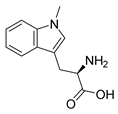 | Prodrug: NLG802 Preferentially inhibit IDO2 Low in vitro activity but effective in vivo | NLG802 is widely absorbed and rapidly metabolized to indimod in all species tested, which is expected to increase the level of clinical drug exposure to indimod, thereby increasing therapeutic effects and expands the treatment population [117]. | ||
| Epacadostat INCB024360  | Selective reversible competitive inhibitor of IDO1 Antitumoral (decreases Tregs, increases synthesis of IFN-γ by T cells) but lack of activity as a monotherapy Metabolized by the intestinal microbiota and the enzyme UGT1A9 (AhR target) | Single agent Pembrolizumab Pembrolizumab/azacitidine Pembrolizumab/chemotherapy INCB001158/pembrolizumab Electroporation/pembrolizumab Nivolumab/Ipilimumab Nivolumab/chemotherapy Durvalumab Cladribine/cytarabine Idarubicin/cytarabine/ Dauno-Rubicin Rapamycin INCMGA00012 + RT + bevacizumab M7824 + BN-Brachyury + ALT-803 + Epacadostat (Immunotherapy) INCMGA00012, Epacadostat 600 mg BID, SV-BR-1-GM combination Intralesional SD101, Radiotherapy | The crystal structure of the complex of human indoleamine 2,3-dioxygenase 1 with its substrate tryptophan, inhibitor epacadostat, and/or effector indole ethanol is introduced. The structural characteristics of the active site that is crucial for substrate activation and the unique small molecule binding site have been revealed [121]. | Phase I/II: peritoneal (NCT01982487, NCT02118285, NCT02042430, NCT02166905, NCT02785250, NCT02575807), thymic (NCT02364076), naso-pharyngeal (NCT04231864), gastric (NCT03196232), gastrointestinal (NCT03291054), pancreatic (NCT03432676, NCT03006302), non-small cell lung (NCT02862457, NCT02298153, NCT03402880, NCT03322566, NCT03322540), head and neck (NCT02178722, NCT03463161, NCT03823131), gastroesophageal (NCT03592407), metastatic colorectal (NCT03182894), and rectal cancer (NCT03516708), melanoma (NCT01961115, NCT01604889), genitourinary (NCT01685255), sarcoma (NCT03414229), solid tumor (NCT01195311, NCT02559492, NCT03361228, NCT03347123, NCT03085914, NCT02318277) Phase III: lung (NCT03348904) (NCT03347123), head and neck carcinoma (NCT03358472, NCT03342352), urothelial (NCT03361865, NCT03374488) and renal carcinoma (NCT03260894) |
| Linrodostat BMS-986205  | Selective, potent, and irreversible IDO1 inhibitor Restores T cell proliferation | Single agent Nivolumab Relatlimab/nivolumab Nivolumab/BCG Itraconazole/rifampin Nivolumab/chemotherapy Nivolumab/radiotherapy or Chemoradiotherapy Omeprazole | The combination of BMS-986205 and nivolumab is well tolerated in heavily pretreated patients, and the combination update safety and efficacy in advanced cancers across all tumor groups [122]. | Phase I/II: liver (NCT03695250), advanced (NCT03792750, NCT03192943, NCT03459222), head and neck (NCT03854032) and bladder cancer (NCT03519256), malignancies multiple (NCT03346837), glioblastoma (NCT04047706), melanoma (NCT04007588, NCT02658890) Phase III: head and neck (NCT03386838), melanoma (NCT03329846), lung (NCT03417037) and bladder cancer (NCT03661320) |
PF-06840003 | Non-competitive specific IDO1 inhibitors Oral use | Single agent | Studies have shown that PF-06840003 (up to 500 mg) has a long-lasting and well-tolerated pharmacological effect in patients with recurrent malignant gliomas [123]. | Phase I/II: malignant gliomas (NCT02764151) |
Navoximod, NLG-919, or GDC-0919 | Reversible moderately selective noncompetitive inhibitor Synergy with indoximod Dose-dependent activation and proliferation of effector T cells Increases survival (± chemotherapy) Currently optimized by prodrug formulation | Single agent | Programmable co-delivery of the immune checkpoint inhibitor NLG919 and chemotherapeutic doxorubicin via a redox-responsive immunostimulating polymeric prodrug carrier. Systemic delivery of DOX via PSSN10 nanocarriers produces synergistic anti-tumor activity [124]. | Phase I/II: solid tumors (NCT02471846, NCT02048709, NCT05469490) |
| KHK2455 | Novel and selective oral IDO-1 inhibitor Long-lasting and potent activity | Avelumab Mogamulizumab | At all doses tested, KHK2455 in combination with mogamulizumab is well tolerated, safe, and dose-dependent; persistently suppresses KYN production; and shows early signals of anti-tumor activity [125]. | Phase I/II: solid tumors (NCT02867007), urothelial carcinoma (NCT03915405), glioblastoma multiforme (NCT04321694) |
LY-3381916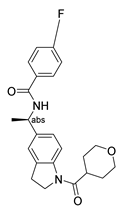 | Potent and selective inhibitor of cell-based IDO1 activity Binding to newly synthesized apo-IDO1 lacking heme | Single agent or in combination with anti-programmed cell death ligand 1 (PD-L1) check-point antibody (LY3300054) | The central nervous system permeability of LY3381916 (rodent kp, uu 0.26) is significant. In addition, as an AhR agonist, a number of heme-binding IDO1 inhibitors have been shown to be a substitute for kynurenine. In addition, LY3381916 is shown to potentiate the activity of an anti-PD-L1 antibody (LY3300054) in a preclinical tumor model, which is associated with enhanced T cell responses [126]. | Phase I/II: solid tumor, non-small cell lung cancer, renal cell carcinoma, triple negative breast cancer (NCT03343613) |
5. Conclusions and Future Perspective
Author Contributions
Funding
Conflicts of Interest
References
- Tanaka, M.; Toth, F.; Polyak, H.; Szabo, A.; Mandi, Y.; Vecsei, L. Immune Influencers in Action: Metabolites and Enzymes of the Tryptophan-Kynurenine Metabolic Pathway. Biomedicines 2021, 9, 734. [Google Scholar] [CrossRef] [PubMed]
- Hoglund, E.; Overli, O.; Winberg, S. Tryptophan Metabolic Pathways and Brain Serotonergic Activity: A Comparative Review. Front. Endocrinol. 2019, 10, 158. [Google Scholar] [CrossRef] [PubMed]
- Zhang, J.; Zhu, S.W.; Ma, N.; Johnston, L.J.; Wu, C.D.; Ma, X. Metabolites of microbiota response to tryptophan and intestinal mucosal immunity: A therapeutic target to control intestinal inflammation. Med. Res. Rev. 2021, 41, 1061–1088. [Google Scholar] [CrossRef] [PubMed]
- Modoux, M.; Rolhion, N.; Mani, S.; Sokol, H. Tryptophan Metabolism as a Pharmacological Target. Trends Pharmacol. Sci. 2021, 42, 60–73. [Google Scholar] [CrossRef]
- Xue, C.; Li, G.; Zheng, Q.; Gu, X.; Shi, Q.; Su, Y.; Chu, Q.; Yuan, X.; Bao, Z.; Lu, J.; et al. Tryptophan metabolism in health and disease. Cell Metab. 2023, 35, 1304–1326. [Google Scholar] [CrossRef]
- Platten, M.; Nollen, E.A.A.; Rohrig, U.F.; Fallarino, F.; Opitz, C.A. Tryptophan metabolism as a common therapeutic target in cancer, neurodegeneration and beyond. Nat. Rev. Drug Discov. 2019, 18, 379–401. [Google Scholar] [CrossRef]
- Dagenais-Lussier, X.; Loucif, H.; Beji, C.; Telittchenko, R.; Routy, J.P.; van Grevenynghe, J. Latest developments in tryptophan metabolism: Understanding its role in B cell immunity. Cytokine Growth Factor Rev. 2021, 59, 111–117. [Google Scholar] [CrossRef]
- Donthu, N.; Kumar, S.; Mukherjee, D.; Pandey, N.; Lim, W.M. How to conduct a bibliometric analysis: An overview and guidelines. J. Bus. Res. 2021, 133, 285–296. [Google Scholar] [CrossRef]
- Yu, Y.T.; Li, Y.J.; Zhang, Z.H.; Gu, Z.C.; Zhong, H.; Zha, Q.F.; Yang, L.Y.; Zhu, C.; Chen, E.Z. A bibliometric analysis using VOSviewer of publications on COVID-19. Ann. Transl. Med. 2020, 8, 13. [Google Scholar] [CrossRef]
- Xu, D.; Wang, Y.L.; Wang, K.T.; Wang, Y.; Dong, X.R.; Tang, J.; Cui, Y.L. A Scientometrics Analysis and Visualization of Depressive Disorder. Curr. Neuropharmacol. 2021, 19, 766–786. [Google Scholar] [CrossRef]
- Xu, G.; Jin, B.; Xian, X.M.; Yang, H.Y.; Zhao, H.T.; Du, S.D.; Makuuchi, M.; Pawlik, T.M.; Mao, Y.L. Evolutions in the Management of Hepatocellular Carcinoma over Last 4 Decades: An Analysis from the 100 Most Influential Articles in the Field. Liver Cancer 2021, 10, 137–150. [Google Scholar] [CrossRef]
- Ma, W.X.; Xu, D.; Zhao, L.; Yuan, M.M.; Cui, Y.L.; Li, Y. Therapeutic role of curcumin in adult neurogenesis for management of psychiatric and neurological disorders: A scientometric study to an in-depth review. Crit. Rev. Food Sci. Nutr. 2022, 63, 9379–9391. [Google Scholar] [CrossRef] [PubMed]
- Aria, M.; Cuccurullo, C. bibliometrix: An R-tool for comprehensive science mapping analysis. J. Informetr. 2017, 11, 959–975. [Google Scholar] [CrossRef]
- Robson, W. The metabolism of tryptophan. III. The mode of formation of kynurenic acid from tryptophan. Biochem. J. 1928, 22, 1165–1168. [Google Scholar] [CrossRef] [PubMed]
- Robson, W. The metabolism of tryptophan. II. Synthesis of 6-methyl- and 8-methylkynurenic acids. Biochem. J. 1928, 22, 1157–1164. [Google Scholar] [CrossRef] [PubMed]
- Su, H.N.; Lee, P.C. Mapping knowledge structure by keyword co-occurrence: A first look at journal papers in Technology Foresight. Scientometrics 2010, 85, 65–79. [Google Scholar] [CrossRef]
- Li, Y.N.; Fang, R.Y.; Liu, Z.H.; Jiang, L.P.; Zhang, J.D.; Li, H.H.; Liu, C.Y.; Li, F. The association between toxic pesticide environmental exposure and Alzheimer’s disease: A scientometric and visualization analysis. Chemosphere 2021, 263, 128238. [Google Scholar] [CrossRef]
- Wu, H.Y.; Tong, L.J.; Wang, Y.L.; Yan, H.; Sun, Z.M. Bibliometric Analysis of Global Research Trends on Ultrasound Microbubble: A Quickly Developing Field. Front. Pharmacol. 2021, 12, 646626. [Google Scholar] [CrossRef]
- Lamas, B.; Richard, M.L.; Leducq, V.; Pham, H.P.; Michel, M.L.; Da Costa, G.; Bridonneau, C.; Jegou, S.; Hoffmann, T.W.; Natividad, J.M.; et al. CARD9 impacts colitis by altering gut microbiota metabolism of tryptophan into aryl hydrocarbon receptor ligands. Nat. Med. 2016, 22, 598–605. [Google Scholar] [CrossRef]
- Nikolaus, S.; Schulte, B.; Al-Massad, N.; Thieme, F.; Schulte, D.M.; Bethge, J.; Rehman, A.; Tran, F.; Aden, K.; Hasler, R.; et al. Increased Tryptophan Metabolism Is Associated with Activity of Inflammatory Bowel Diseases. Gastroenterology 2017, 153, 1504–1516. [Google Scholar] [CrossRef]
- Golubeva, A.V.; Joyce, S.A.; Moloney, G.; Burokas, A.; Sherwin, E.; Arboleya, S.; Flynn, I.; Khochanskiy, D.; Moya-Perez, A.; Peterson, V.; et al. Microbiota-related Changes in Bile Acid & Tryptophan Metabolism are Associated with Gastrointestinal Dysfunction in a Mouse Model of Autism. eBioMedicine 2017, 24, 166–178. [Google Scholar] [CrossRef] [PubMed]
- Friedrich, M.; Sankowski, R.; Bunse, L.; Kilian, M.; Green, E.; Guevara, C.R.; Pusch, S.; Poschet, G.; Sanghvi, K.; Hahn, M.; et al. Tryptophan metabolism drives dynamic immunosuppressive myeloid states in IDH-mutant gliomas. Nat. Cancer 2021, 2, 723–740. [Google Scholar] [CrossRef] [PubMed]
- Wrzosek, L.; Ciocan, D.; Hugot, C.; Spatz, M.; Dupeux, M.; Houron, C.; Lievin-Le Moal, V.; Puchois, V.; Ferrere, G.; Trainel, N.; et al. Microbiota tryptophan metabolism induces aryl hydrocarbon receptor activation and improves alcohol-induced liver injury. Gut 2021, 70, 1299–1308. [Google Scholar] [CrossRef] [PubMed]
- Yang, W.Q.; Ren, D.Y.; Zhao, Y.; Liu, L.; Yang, X.B. Fuzhuan Brick Tea Polysaccharide Improved Ulcerative Colitis in Association with Gut Microbiota-Derived Tryptophan Metabolism. J. Agric. Food Chem. 2021, 69, 8448–8459. [Google Scholar] [CrossRef]
- Zhang, Z.J.; Mu, X.H.; Cao, Q.N.; Shi, Y.; Hu, X.S.; Zheng, H. Honeybee gut Lactobacillus modulates host learning and memory behaviors via regulating tryptophan metabolism. Nat. Commun. 2022, 13, 2037. [Google Scholar] [CrossRef]
- Agus, A.; Planchais, J.; Sokol, H. Gut Microbiota Regulation of Tryptophan Metabolism in Health and Disease. Cell Host Microbe 2018, 23, 716–724. [Google Scholar] [CrossRef]
- Benech, N.; Rolhion, N.; Sokol, H. Gut Microbiota Reprogramming of Tryptophan Metabolism during Pregnancy Shapes Host Insulin Resistance. Gastroenterology 2022, 162, 1587–1589. [Google Scholar] [CrossRef]
- Dudzinska, E.; Szymona, K.; Kloc, R.; Gil-Kulik, P.; Kocki, T.; Swistowska, M.; Bogucki, J.; Kocki, J.; Urbanska, E.M. Increased expression of kynurenine aminotransferases mRNA in lymphocytes of patients with inflammatory bowel disease. Ther. Adv. Gastroenterol. 2019, 12, 1756284819881304. [Google Scholar] [CrossRef]
- Michaudel, C.; Danne, C.; Agus, A.; Magniez, A.; Aucouturier, A.; Spatz, M.; Lefevre, A.; Kirchgesner, J.; Rolhion, N.; Wang, Y.Z.; et al. Rewiring the altered tryptophan metabolism as a novel therapeutic strategy in inflammatory bowel diseases. Gut 2022, 72, 1296–1307. [Google Scholar] [CrossRef]
- Sofia, M.A.; Ciorba, M.A.; Meckel, K.; Lim, C.K.; Guillemin, G.J.; Weber, C.R.; Bissonnette, M.; Pekow, J.R. Tryptophan Metabolism through the Kynurenine Pathway is Associated with Endoscopic Inflammation in Ulcerative Colitis. Inflamm. Bowel Dis. 2018, 24, 1471–1480. [Google Scholar] [CrossRef]
- Schiering, C.; Wincent, E.; Metidji, A.; Iseppon, A.; Li, Y.; Potocnik, A.J.; Omenetti, S.; Henderson, C.J.; Wolf, C.R.; Neberts, D.W.; et al. Feedback control of AHR signalling regulates intestinal immunity. Nature 2017, 542, 242–245. [Google Scholar] [CrossRef] [PubMed]
- Gibson, G.R.; Hutkins, R.; Sanders, M.E.; Prescott, S.L.; Reimer, R.A.; Salminen, S.J.; Scott, K.; Stanton, C.; Swanson, K.S.; Cani, P.D.; et al. The International Scientific Association for Probiotics and Prebiotics (ISAPP) consensus statement on the definition and scope of prebiotics. Nat. Rev. Gastroenterol. Hepatol. 2017, 14, 491–502. [Google Scholar] [CrossRef] [PubMed]
- Kennedy, P.J.; Cryan, J.F.; Dinan, T.G.; Clarke, G. Kynurenine pathway metabolism and the microbiota-gut-brain axis. Neuropharmacology 2017, 112, 399–412. [Google Scholar] [CrossRef] [PubMed]
- Lemos, H.; Huang, L.; Prendergast, G.C.; Mellor, A.L. Immune control by amino acid catabolism during tumorigenesis and therapy. Nat. Rev. Cancer 2019, 19, 162–175. [Google Scholar] [CrossRef]
- Brochez, L.; Meireson, A.; Chevolet, I.; Sundahl, N.; Ost, P.; Kruse, V. Challenging PD-L1 expressing cytotoxic T cells as a predictor for response to immunotherapy in melanoma. Nat. Commun. 2018, 9, 2921. [Google Scholar] [CrossRef]
- Lim, C.K.; Fernández-Gomez, F.J.; Braidy, N.; Estrada, C.; Costa, C.; Costa, S.; Bessede, A.; Fernandez-Villalba, E.; Zinger, A.; Herrero, M.T.; et al. Involvement of the kynurenine pathway in the pathogenesis of Parkinson’s disease. Prog. Neurobiol. 2017, 155, 76–95. [Google Scholar] [CrossRef]
- Chini, C.C.S.; Zeidler, J.D.; Kashyap, S.; Warner, G.; Chini, E.N. Evolving concepts in NAD(+) metabolism. Cell Metab. 2021, 33, 1076–1087. [Google Scholar] [CrossRef]
- Jenkins, T.A.; Nguyen, J.C.D.; Polglaze, K.E.; Bertrand, P.P. Influence of Tryptophan and Serotonin on Mood and Cognition with a Possible Role of the Gut-Brain Axis. Nutrients 2016, 8, 56. [Google Scholar] [CrossRef]
- Mawe, G.M.; Hoffman, J.M. Serotonin signalling in the gut-functions, dysfunctions and therapeutic targets. Nat. Rev. Gastroenterol. Hepatol. 2013, 10, 473–486. [Google Scholar] [CrossRef]
- Herr, N.; Bode, C.; Duerschmied, D. The Effects of Serotonin in Immune Cells. Front. Cardiovasc. Med. 2017, 4, 48. [Google Scholar] [CrossRef]
- Jayamohanan, H.; Kumar, M.K.M.; Aneesh, T.P. 5-HIAA as a Potential Biological Marker for Neurological and Psychiatric Disorders. Adv. Pharm. Bull. 2019, 9, 374–381. [Google Scholar] [CrossRef] [PubMed]
- Knudsen, C.; Neyrinck, A.M.; Leyrolle, Q.; Baldin, P.; Leclercq, S.; Rodriguez, J.; Beaumont, M.; Cani, P.D.; Bindels, L.B.; Lanthier, N.; et al. Hepatoprotective Effects of Indole, a Gut Microbial Metabolite, in Leptin-Deficient Obese Mice. J. Nutr. 2021, 151, 1507–1516. [Google Scholar] [CrossRef] [PubMed]
- Serger, E.; Luengo-Gutierrez, L.; Chadwick, J.S.; Kong, G.P.; Zhou, L.M.; Crawford, G.; Danzi, M.C.; Myridakis, A.; Brandis, A.; Bello, A.T.; et al. The gut metabolite indole-3 propionate promotes nerve regeneration and repair. Nature 2022, 607, 585–592. [Google Scholar] [CrossRef] [PubMed]
- Sadik, A.; Patterson, L.F.S.; Ozturk, S.; Mohapatra, S.R.; Panitz, V.; Secker, P.F.; Pfander, P.; Loth, S.; Salem, H.; Prentzell, M.T.; et al. IL4I1 Is a Metabolic Immune Checkpoint that Activates the AHR and Promotes Tumor Progression. Cell 2020, 182, 1252–1270. [Google Scholar] [CrossRef] [PubMed]
- Zhang, L.S.; Davies, S.S. Microbial metabolism of dietary components to bioactive metabolites: Opportunities for new therapeutic interventions. Genome Med. 2016, 8, 46. [Google Scholar] [CrossRef]
- Sjögren, K.; Engdahl, C.; Henning, P.; Lerner, U.H.; Tremaroli, V.; Lagerquist, M.K.; Bäckhed, F.; Ohlsson, C. The gut microbiota regulates bone mass in mice. J. bone Miner. Res. 2012, 27, 1357–1367. [Google Scholar] [CrossRef]
- Wikoff, W.R.; Anfora, A.T.; Liu, J.; Schultz, P.G.; Lesley, S.A.; Peters, E.C.; Siuzdak, G. Metabolomics analysis reveals large effects of gut microflora on mammalian blood metabolites. Proc. Natl. Acad. Sci. USA 2009, 106, 3698–3703. [Google Scholar] [CrossRef]
- Reigstad, C.S.; Salmonson, C.E.; Rainey, J.F.; Szurszewski, J.H.; Linden, D.R.; Sonnenburg, J.L.; Farrugia, G.; Kashyap, P.C. Gut microbes promote colonic serotonin production through an effect of short-chain fatty acids on enterochromaffin cells. Faseb J. 2015, 29, 1395–1403. [Google Scholar] [CrossRef]
- Gao, K.; Mu, C.L.; Farzi, A.; Zhu, W.Y. Tryptophan Metabolism: A Link between the Gut Microbiota and Brain. Adv. Nutr. 2020, 11, 709–723. [Google Scholar] [CrossRef]
- Mahanonda, R.; Sa-Ard-Iam, N.; Montreekachon, P.; Pimkhaokham, A.; Yongvanichit, K.; Fukuda, M.M.; Pichyangkul, S. IL-8 and IDO expression by human gingival fibroblasts via TLRs. J. Immunol. 2007, 178, 1151–1157. [Google Scholar] [CrossRef]
- Suh, H.S.; Zhao, M.L.; Rivieccio, M.; Choi, S.; Connolly, E.; Zhao, Y.; Takikawa, O.; Brosnan, C.F.; Lee, S.C. Astrocyte indoleamine 2,3-dioxygenase is induced by the TLR3 ligand Poly(I:C):: Mechanism of induction and role in antiviral response. J. Virol. 2007, 81, 9838–9850. [Google Scholar] [CrossRef] [PubMed]
- Vujkovic-Cvijin, I.; Dunham, R.M.; Iwai, S.; Maher, M.C.; Albright, R.G.; Broadhurst, M.J.; Hernandez, R.D.; Lederman, M.M.; Huang, Y.; Somsouk, M.; et al. Dysbiosis of the Gut Microbiota Is Associated with HIV Disease Progression and Tryptophan Catabolism. Sci. Transl. Med. 2013, 5, 193ra91. [Google Scholar] [CrossRef] [PubMed]
- O’Mahony, S.M.; Clarke, G.; Borre, Y.E.; Dinan, T.G.; Cryan, J.F. Serotonin, tryptophan metabolism and the brain-gut-microbiome axis. Behav. Brain Res. 2015, 277, 32–48. [Google Scholar] [CrossRef] [PubMed]
- Cervenka, I.; Agudelo, L.Z.; Ruas, J.L. Kynurenines: Tryptophan’s metabolites in exercise, inflammation, and mental health. Science 2017, 357, eaaf9794. [Google Scholar] [CrossRef]
- Xie, L.S.; Wu, Q.F.; Li, K.L.; Khan, M.A.S.; Zhang, A.D.; Sinha, B.; Li, S.H.; Chang, S.L.; Brody, D.L.; Grinstaff, M.W.; et al. Tryptophan Metabolism in Alzheimer’s Disease with the Involvement of Microglia and Astrocyte Crosstalk and Gut-Brain Axis. Aging Dis. 2024, 15, 2168–2190. [Google Scholar] [CrossRef]
- Ye, L.H.; Bae, M.; Cassilly, C.D.; Jabba, S.V.; Thorpe, D.W.; Martin, A.M.; Lu, H.Y.; Wang, J.H.; Thompson, J.D.; Lickwar, C.R.; et al. Enteroendocrine cells sense bacterial tryptophan catabolites to activate enteric and vagal neuronal pathways. Cell Host Microbe 2021, 29, 179–196. [Google Scholar] [CrossRef]
- Jaglin, M.; Rhimi, M.; Philippe, C.; Pons, N.; Bruneau, A.; Goustard, B.; Daugé, V.; Maguin, E.; Naudon, L.; Rabot, S. Indole, a Signaling Molecule Produced by the Gut Microbiota, Negatively Impacts Emotional Behaviors in Rats. Front. Neurosci. 2018, 12, 216. [Google Scholar] [CrossRef]
- Jennis, M.; Cavanaugh, C.R.; Leo, G.C.; Mabus, J.R.; Lenhard, J.; Hornby, P.J. Microbiota-derived tryptophan indoles increase after gastric bypass surgery and reduce intestinal permeability in vitro and in vivo. Neurogastroenterol. Motil. 2018, 30, e13178. [Google Scholar] [CrossRef]
- Mangoni, A.A.; Zinellu, A. A systematic review and meta-analysis of the kynurenine pathway of tryptophan metabolism in rheumatic diseases. Front. Immunol. 2023, 14, 1257159. [Google Scholar] [CrossRef]
- Seo, S.K.; Kwon, B. Immune regulation through tryptophan metabolism. Exp. Mol. Med. 2023, 55, 1371–1379. [Google Scholar] [CrossRef]
- Platten, M.; Friedrich, M.; Wainwright, D.A.; Panitz, V.; Opitz, C.A. Tryptophan metabolism in brain tumors-IDO and beyond. Curr. Opin. Immunol. 2021, 70, 57–66. [Google Scholar] [CrossRef] [PubMed]
- Yu, L.; Lu, J.; Du, W.B. Tryptophan metabolism in digestive system tumors: Unraveling the pathways and implications. Cell Commun. Signal. 2024, 22, 174. [Google Scholar] [CrossRef] [PubMed]
- Prompetchara, E.; Kettoy, C.; Palaga, T. Immune responses in COVID-19 and potential vaccines: Lessons learned from SARS and MERS epidemic. Asian Pac. J. Allergy Immunol. 2020, 38, 1–9. [Google Scholar] [CrossRef] [PubMed]
- Takeshita, H.; Yamamoto, K. Tryptophan Metabolism and COVID-19-Induced Skeletal Muscle Damage: Is ACE2 a Key Regulator? Front. Nutr. 2022, 9, 868845. [Google Scholar] [CrossRef] [PubMed]
- Chai, R.D.; Fan, Y.D.; Li, Q.Y.; Cui, H.T.; Liu, H.Z.; Wang, Y.; Gong, B.Y.; Han, L.; Zhang, S.; Bian, Y.H. Traditional Chinese medicine:an important broad-spectrum anti-coronavirus treatment strategy on COVID-19 background? Tradit. Med. Res. 2022, 7, 19. [Google Scholar] [CrossRef]
- Li, X.; Wichai, N.; Wang, J.; Liu, X.; Yan, H.; Wang, Y.; Luo, M.; Zhou, S.; Wang, K.; Li, L.; et al. Regulation of innate and adaptive immunity using herbal medicine: Benefits for the COVID-19 vaccination. Acupunct. Herb. Med. 2022, 2, 196–206. [Google Scholar] [CrossRef]
- Wang, L.; Hu, X.; Geng, L.; Li, N.; Chen, Y.; Zhang, J.; Yuan, X.; Huang, L.; Ba, D.; Lian, J.; et al. Multi-effective characteristics and advantages of acupuncture in COVID-19 treatment. Acupunct. Herb. Med. 2023, 3, 83–95. [Google Scholar] [CrossRef]
- Xiao, G.; Wang, S.; Wang, R.; Tan, L.; Ma, S.; He, S.; Fan, G.; Zhu, Y.; Lyu, M. “Three medicines and three formulas” in COVID-19: From bench to bedside. Acupunct. Herb. Med. 2023, 3, 309–322. [Google Scholar] [CrossRef]
- Belladonna, M.L.; Orabona, C. Potential Benefits of Tryptophan Metabolism to the Efficacy of Tocilizumab in COVID-19. Front. Pharmacol. 2020, 11, 959. [Google Scholar] [CrossRef]
- Thomas, T.; Stefanoni, D.; Reisz, J.A.; Nemkov, T.; Bertolone, L.; Francis, R.O.; Hudson, K.E.; Zimring, J.C.; Hansen, K.C.; Hod, E.A.; et al. COVID-19 infection alters kynurenine and fatty acid metabolism, correlating with IL-6 levels and renal status. JCI Insight 2020, 5, e140327. [Google Scholar] [CrossRef]
- Cai, Y.P.; Kim, D.J.; Takahashi, T.; Broadhurst, D.I.; Yan, H.; Ma, S.G.; Rattray, N.J.W.; Casanovas-Massana, A.; Israelow, B.; Klein, J.; et al. Kynurenic acid may underlie sex-specific immune responses to COVID-19. Sci. Signal. 2021, 14, eabf8483. [Google Scholar] [CrossRef] [PubMed]
- Munn, D.H.; Zhou, M.; Attwood, J.T.; Bondarev, I.; Conway, S.J.; Marshall, B.; Brown, C.; Mellor, A.L. Prevention of allogeneic fetal rejection by tryptophan catabolism. Science 1998, 281, 1191–1193. [Google Scholar] [CrossRef] [PubMed]
- Campesato, L.F.; Budhu, S.; Tchaicha, J.; Weng, C.H.; Gigoux, M.; Cohen, I.J.; Redmond, D.; Mangarin, L.; Pourpe, S.; Liu, C.L.; et al. Blockade of the AHR restricts a Treg-macrophage suppressive axis induced by L-Kynurenine. Nat. Commun. 2020, 11, 4011. [Google Scholar] [CrossRef] [PubMed]
- Badawy, A.A. The kynurenine pathway of tryptophan metabolism: A neglected therapeutic target of COVID-19 pathophysiology and immunotherapy. Biosci. Rep. 2023, 43, BSR20230595. [Google Scholar] [CrossRef] [PubMed]
- Orabona, C.; Pallotta, M.T.; Grohmann, U. Different Partners, Opposite Outcomes: A New Perspective of the Immunobiology of Indoleamine 2,3-Dioxygenase. Mol. Med. 2012, 18, 834–842. [Google Scholar] [CrossRef]
- Mondanelli, G.; Albini, E.; Pallotta, M.T.; Volpi, C.; Chatenoud, L.; Kuhn, C.; Fallarino, F.; Matino, D.; Belladonna, M.L.; Bianchi, R.; et al. The Proteasome Inhibitor Bortezomib Controls Indoleamine 2,3-Dioxygenase 1 Breakdown and Restores Immune Regulation in Autoimmune Diabetes. Front. Immunol. 2017, 8, 428. [Google Scholar] [CrossRef]
- Hoshi, M.; Saito, K.; Hara, A.; Taguchi, A.; Ohtaki, H.; Tanaka, R.; Fujigaki, H.; Osawa, Y.; Takemura, M.; Matsunami, H.; et al. The Absence of IDO Upregulates Type I IFN Production, Resulting in Suppression of Viral Replication in the Retrovirus-Infected Mouse. J. Immunol. 2010, 185, 3305–3312. [Google Scholar] [CrossRef]
- Yamada, T.; Horimoto, H.; Kameyama, T.; Hayakawa, S.; Yamato, H.; Dazai, M.; Takada, A.; Kida, H.; Bott, D.; Zhou, A.C.; et al. Constitutive aryl hydrocarbon receptor signaling constrains type I interferon-mediated antiviral innate defense. Nat. Immunol. 2016, 17, 687–694. [Google Scholar] [CrossRef]
- Ostrom, Q.T.; Cioffi, G.; Waite, K.; Kruchko, C.; Barnholtz-Sloan, J.S. CBTRUS Statistical Report: Primary Brain and Other Central Nervous System Tumors Diagnosed in the United States in 2014–2018. Neuro-Oncology 2021, 23, iii1–iii105. [Google Scholar] [CrossRef]
- Xu, Y.; Zhang, H.K.; Sun, Q.; Geng, R.X.; Yuan, F.E.; Liu, B.H.; Chen, Q.X. Immunomodulatory Effects of Tryptophan Metabolism in the Glioma Tumor Microenvironment. Front. Immunol. 2021, 12, 730289. [Google Scholar] [CrossRef]
- Greene, L.I.; Bruno, T.C.; Christenson, J.L.; D’Alessandro, A.; Culp-Hill, R.; Torkko, K.; Borges, V.F.; Slansky, J.E.; Richer, J.K. A Role for Tryptophan-2,3-dioxygenase in CD8 T-cell Suppression and Evidence of Tryptophan Catabolism in Breast Cancer Patient Plasma. Mol. Cancer Res. 2019, 17, 131–139. [Google Scholar] [CrossRef] [PubMed]
- DiNatale, B.C.; Murray, I.A.; Schroeder, J.C.; Flaveny, C.A.; Lahoti, T.S.; Laurenzana, E.M.; Omiecinski, C.J.; Perdew, G.H. Kynurenic Acid Is a Potent Endogenous Aryl Hydrocarbon Receptor Ligand that Synergistically Induces Interleukin-6 in the Presence of Inflammatory Signaling. Toxicol. Sci. 2010, 115, 89–97. [Google Scholar] [CrossRef] [PubMed]
- Nguyen, N.T.; Kimura, A.; Nakahama, T.; Chinen, I.; Masuda, K.; Nohara, K.; Fujii-Kuriyama, Y.; Kishimoto, T. Aryl hydrocarbon receptor negatively regulates dendritic cell immunogenicity via a kynurenine-dependent mechanism. Proc. Natl. Acad. Sci. USA 2010, 107, 19961–19966. [Google Scholar] [CrossRef] [PubMed]
- Opitz, C.A.; Litzenburger, U.M.; Sahm, F.; Ott, M.; Tritschler, I.; Trump, S.; Schumacher, T.; Jestaedt, L.; Schrenk, D.; Weller, M.; et al. An endogenous tumour-promoting ligand of the human aryl hydrocarbon receptor. Nature 2011, 478, 197–203. [Google Scholar] [CrossRef]
- Hao, S.Y.; Huang, G.Y.; Feng, J.; Li, D.; Wang, K.; Wang, L.; Wu, Z.; Wan, H.; Zhang, L.W.; Zhang, J.T. Non-NF2 mutations have a key effect on inhibitory immune checkpoints and tumor pathogenesis in skull base meningiomas. J. Neuro-Oncol. 2019, 144, 11–20. [Google Scholar] [CrossRef]
- Guastellal, A.R.; Michelhaugh, S.K.; Klinger, N.V.; Fadel, H.A.; Kiousis, S.; Ali-Fehmi, R.; Kupsky, W.J.; Juhasz, C.; Mittal, S. Investigation of the aryl hydrocarbon receptor and the intrinsic tumoral component of the kynurenine pathway of tryptophan metabolism in primary brain tumors. J. Neuro-Oncol. 2018, 139, 239–249. [Google Scholar] [CrossRef]
- Theate, I.; van Baren, N.; Pilotte, L.; Moulin, P.; Larrieu, P.; Renauld, J.C.; Herve, C.; Gutierrez-Roelens, I.; Marbaix, E.; Sempoux, C.; et al. Extensive Profiling of the Expression of the Indoleamine 2,3-Dioxygenase 1 Protein in Normal and Tumoral Human Tissues. Cancer Immunol. Res. 2015, 3, 161–172. [Google Scholar] [CrossRef]
- Zhong, C.H.; Peng, L.L.; Tao, B.; Yin, S.L.; Lyu, L.; Ding, H.; Yang, X.B.; Peng, T.M.; He, H.P.; Zhou, P.Z. TDO2 and tryptophan metabolites promote kynurenine/AhR signals to facilitate glioma progression and immunosuppression. Am. J. Cancer Res. 2022, 12, 2558. [Google Scholar]
- Du, L.S.; Xing, Z.K.; Tao, B.B.; Li, T.Q.; Yang, D.; Li, W.R.; Zheng, Y.T.; Kuang, C.X.; Yang, Q. Both IDO1 and TDO contribute to the malignancy of gliomas via the Kyn-AhR-AQP4 signaling pathway. Signal Transduct. Target. Ther. 2020, 5, 10. [Google Scholar] [CrossRef]
- Fallarino, F.; Grohmann, U.; Hwang, K.W.; Orabona, C.; Vacca, C.; Bianchi, R.; Belladonna, M.L.; Fioretti, M.C.; Alegre, M.L.; Puccetti, P. Modulation of tryptophan catabolism by regulatory T cells. Nat. Immunol. 2003, 4, 1206–1212. [Google Scholar] [CrossRef]
- Mezrich, J.D.; Fechner, J.H.; Zhang, X.J.; Johnson, B.P.; Burlingham, W.J.; Bradfield, C.A. An Interaction between Kynurenine and the Aryl Hydrocarbon Receptor Can Generate Regulatory T Cells. J. Immunol. 2010, 185, 3190–3198. [Google Scholar] [CrossRef] [PubMed]
- Zhang, S.X.; Chen, S.L.; Wang, Z.H.; Li, J.H.; Yuan, Y.B.; Feng, W.T.; Li, W.H.; Chen, M.A.; Liu, Y.H. Prognosis prediction and tumor immune microenvironment characterization based on tryptophan metabolism-related genes signature in brain glioma. Front. Pharmacol. 2022, 13, 1061597. [Google Scholar] [CrossRef] [PubMed]
- Commisso, C.; Davidson, S.M.; Soydaner-Azeloglu, R.G.; Parker, S.J.; Kamphorst, J.J.; Hackett, S.; Grabocka, E.; Nofal, M.; Drebin, J.A.; Thompson, C.B.; et al. Macropinocytosis of protein is an amino acid supply route in Ras-transformed cells. Nature 2013, 497, 633–637. [Google Scholar] [CrossRef] [PubMed]
- Mayers, J.R.; Torrence, M.E.; Danai, L.V.; Papagiannakopoulos, T.; Davidson, S.M.; Bauer, M.R.; Lau, A.N.; Ji, B.W.; Dixit, P.D.; Hosios, A.M.; et al. Tissue of origin dictates branched-chain amino acid metabolism in mutant Kras-driven cancers. Science 2016, 353, 1161–1165. [Google Scholar] [CrossRef]
- Nerurkar, L.; Siebert, S.; McInnes, I.B.; Cavanagh, J. Rheumatoid arthritis and depression: An inflammatory perspective. Lancet Psychiatry 2019, 6, 164–173. [Google Scholar] [CrossRef]
- Bisgaard, T.H.; Allin, K.H.; Keefer, L.; Ananthakrishnan, A.N.; Jess, T. Depression and anxiety in inflammatory bowel disease: Epidemiology, mechanisms and treatment. Nat. Rev. Gastroenterol. Hepatol. 2022, 19, 717–726. [Google Scholar] [CrossRef]
- Kim, H.; Chen, L.; Lim, G.; Sung, B.; Wang, S.X.; McCabe, M.F.; Rusanescu, G.; Yang, L.L.; Tian, Y.H.; Mao, J.R. Brain indoleamine 2,3-dioxygenase contributes to the comorbidity of pain and depression. J. Clin. Investig. 2012, 122, 2940–2954. [Google Scholar] [CrossRef]
- Lawson, M.A.; Parrott, J.M.; McCusker, R.H.; Dantzer, R.; Kelley, K.W.; O’Connor, J.C. Intracerebroventricular administration of lipopolysaccharide induces indoleamine-2,3-dioxygenase-dependent depression-like behaviors. J. Neuroinflammation 2013, 10, 87. [Google Scholar] [CrossRef]
- Qin, Y.J.; Wang, N.X.; Zhang, X.L.; Han, X.M.; Zhai, X.J.; Lu, Y.N. IDO and TDO as a potential therapeutic target in different types of depression. Metab. Brain Dis. 2018, 33, 1787–1800. [Google Scholar] [CrossRef]
- O’Connor, J.C.; Andre, C.; Wang, Y.X.; Lawson, M.A.; Szegedi, S.S.; Lestage, J.; Castanon, N.; Kelley, K.W.; Dantzer, R. Interferon-gamma and Tumor Necrosis Factor-alpha Mediate the Upregulation of Indoleamine 2,3-Dioxygenase and the Induction of Depressive-Like Behavior in Mice in Response to Bacillus Calmette-Guerin. J. Neurosci. 2009, 29, 4200–4209. [Google Scholar] [CrossRef]
- Miura, H.; Ozaki, N.; Sawada, M.; Isobe, K.; Ohta, T.; Nagatsu, T. A link between stress and depression: Shifts in the balance between the kynurenine and serotonin pathways of tryptophan metabolism and the etiology and pathophysiology of depression. Stress 2008, 11, 198–209. [Google Scholar] [CrossRef] [PubMed]
- Laumet, G.; Zhou, W.J.; Dantzer, R.; Edralin, J.D.; Huo, X.J.; Budac, D.P.; O’Connor, J.C.; Lee, A.W.; Heijnen, C.J.; Kavelaars, A. Upregulation of neuronal kynurenine 3-monooxygenase mediates depression-like behavior in a mouse model of neuropathic pain. Brain Behav. Immun. 2017, 66, 94–102. [Google Scholar] [CrossRef] [PubMed]
- Claes, S.; Myint, A.M.; Domschke, K.; Del-Favero, J.; Entrich, K.; Engelborghs, S.; De Deyn, P.; Mueller, N.; Baune, B.; Rothermundt, M. The kynurenine pathway in major depression: Haplotype analysis of three related functional candidate genes. Psychiatry Res. 2011, 188, 355–360. [Google Scholar] [CrossRef] [PubMed]
- Walker, A.K.; Budac, D.P.; Bisulco, S.; Lee, A.W.; Smith, R.A.; Beenders, B.; Kelley, K.W.; Dantzer, R. NMDA Receptor Blockade by Ketamine Abrogates Lipopolysaccharide-Induced Depressive-Like Behavior in C57BL/6J Mice. Neuropsychopharmacology 2013, 38, 1609–1616. [Google Scholar] [CrossRef]
- Haroon, E.; Welle, J.R.; Woolwine, B.J.; Goldsmith, D.R.; Baer, W.; Patel, T.; Felger, J.C.; Miller, A.H. Associations among peripheral and central kynurenine pathway metabolites and inflammation in depression. Neuropsychopharmacology 2020, 45, 998–1007. [Google Scholar] [CrossRef]
- Chen, L.M.; Bao, C.H.; Wu, Y.; Liang, S.H.; Wang, D.; Wu, L.Y.; Huang, Y.; Liu, H.R.; Wu, H.G. Tryptophan-kynurenine metabolism: A link between the gut and brain for depression in inflammatory bowel disease. J. Neuroinflammation 2021, 18, 135. [Google Scholar] [CrossRef]
- Savitz, J. The kynurenine pathway: A finger in every pie. Mol. Psychiatr. 2020, 25, 131–147. [Google Scholar] [CrossRef]
- Wigner, P.; Czarny, P.; Synowiec, E.; Bijak, M.; Bialek, K.; Talarowska, M.; Galecki, P.; Szemraj, J.; Sliwinski, T. Association between single nucleotide polymorphisms of TPH1 and TPH2 genes, and depressive disorders. J. Cell. Mol. Med. 2018, 22, 1778–1791. [Google Scholar] [CrossRef]
- Fukuda, K. Etiological classification of depression based on the enzymes of tryptophan metabolism. BMC Psychiatry 2014, 14, 372. [Google Scholar] [CrossRef]
- Steiner, J.; Walter, M.; Gos, T.; Guillemin, G.J.; Bernstein, H.G.; Sarnyai, Z.; Mawrin, C.; Brisch, R.; Bielau, H.; Schwabedissen, L.M.Z.; et al. Severe depression is associated with increased microglial quinolinic acid in subregions of the anterior cingulate gyrus: Evidence for an immune-modulated glutamatergic neurotransmission? J. Neuroinflammation 2011, 8, 94. [Google Scholar] [CrossRef]
- Schwarcz, R.; Bruno, J.P.; Muchowski, P.J.; Wu, H.Q. Kynurenines in the mammalian brain: When physiology meets pathology. Nat. Rev. Neurosci. 2012, 13, 465–477. [Google Scholar] [CrossRef] [PubMed]
- Verdonk, F.; Petit, A.C.; Abdel-Ahad, P.; Vinckier, F.; Jouvion, G.; de Maricourt, P.; De Medeiros, G.F.; Danckaert, A.; Van Steenwinckel, J.; Blatzer, M.; et al. Microglial production of quinolinic acid as a target and a biomarker of the antidepressant effect of ketamine. Brain Behav. Immun. 2019, 81, 361–373. [Google Scholar] [CrossRef] [PubMed]
- Belleau, E.L.; Treadway, M.T.; Pizzagalli, D.A. The Impact of Stress and Major Depressive Disorder on Hippocampal and Medial Prefrontal Cortex Morphology. Biol. Psychiatry 2019, 85, 443–453. [Google Scholar] [CrossRef] [PubMed]
- Young, K.D.; Drevets, W.C.; Dantzer, R.; Teague, T.K.; Bodurka, J.; Savitz, J. Kynurenine pathway metabolites are associated with hippocampal activity during autobiographical memory recall in patients with depression. Brain Behav. Immun. 2016, 56, 335–342. [Google Scholar] [CrossRef] [PubMed]
- Wang, Q.S.; Yan, K.; Li, K.D.; Gao, L.N.; Wang, X.; Liu, H.B.; Zhang, Z.G.; Li, K.F.; Cui, Y.L. Targeting hippocampal phospholipid and tryptophan metabolism for antidepressant-like effects of albiflorin. Phytomedicine 2021, 92, 153735. [Google Scholar] [CrossRef]
- Yu, L.B.; Wang, Y.Y.; He, Y.X.; Zhong, H.Q.; Ge, S.S.; Zou, Y.; Lai, Y.S.; Xu, Q.; Gao, J.; Liu, W.; et al. Combination of apatinib with apo-IDO1 inhibitor for the treatment of colorectal cancer. Int. Immunopharmacol. 2022, 112, 109233. [Google Scholar] [CrossRef]
- Kumar, S.; Jaipuri, F.A.; Waldo, J.P.; Potturi, H.; Marcinowicz, A.; Adams, J.; Van Allen, C.; Zhuang, H.; Vahanian, N.; Link, C.; et al. Discovery of indoximod prodrugs and characterization of clinical candidate NLG802. Eur. J. Med. Chem. 2020, 198, 112373. [Google Scholar] [CrossRef]
- Zhang, R.J.; Wang, Y.F.Y.; Liu, D.; Luo, Q.; Du, P.X.; Zhang, H.Y.; Wu, W.S. Sodium Tanshinone IIA Sulfonate as a Potent IDO1/TDO2 Dual Inhibitor Enhances Anti-PD1 Therapy for Colorectal Cancer in Mice. Front. Pharmacol. 2022, 13, 870848. [Google Scholar] [CrossRef]
- Liang, H.; Li, T.Q.; Fang, X.; Xing, Z.K.; Zhang, S.N.; Shi, L.; Li, W.R.; Guo, L.L.; Kuang, C.X.; Liu, H.R.; et al. IDO1/TDO dual inhibitor RY103 targets Kyn-AhR pathway and exhibits preclinical efficacy on pancreatic cancer. Cancer Lett. 2021, 522, 32–43. [Google Scholar] [CrossRef]
- Wirthgen, E.; Leonard, A.K.; Scharf, C.; Domanska, G. The Immunomodulator 1-Methyltryptophan Drives Tryptophan Catabolism Toward the Kynurenic Acid Branch. Front. Immunol. 2020, 11, 313. [Google Scholar] [CrossRef]
- Lewis-Ballester, A.; Pham, K.N.; Batabyal, D.; Karkashon, S.; Bonanno, J.B.; Poulos, T.L.; Yeh, S.R. Structural insights into substrate and inhibitor binding sites in human indoleamine 2,3-dioxygenase 1. Nat. Commun. 2017, 8, 1693. [Google Scholar] [CrossRef] [PubMed]
- Luke, J.J.; Tabernero, J.; Joshua, A.; Desai, J.; Varga, A.I.; Moreno, V.; Gomez-Roca, C.A.; Markman, B.; De Braud, F.G.; Patel, S.P.; et al. BMS-986205, an indoleamine 2, 3-dioxygenase 1 inhibitor (IDO1i), in combination with nivolumab (nivo): Updated safety across all tumor cohorts and efficacy in advanced bladder cancer (advBC). J. Clin. Oncol. 2019, 37, 358. [Google Scholar] [CrossRef]
- Reardon, D.A.; Desjardins, A.; Rixe, O.; Cloughesy, T.; Alekar, S.; Williams, J.H.; Li, R.; Taylor, C.T.; Lassman, A.B. A phase 1 study of PF-06840003, an oral indoleamine 2,3-dioxygenase 1 (IDO1) inhibitor in patients with recurrent malignant glioma. Investig. New Drugs 2020, 38, 1784–1795. [Google Scholar] [CrossRef] [PubMed]
- Sun, J.J.; Chen, Y.C.; Huang, Y.X.; Zhao, W.C.; Liu, Y.H.; Venkataramanan, R.; Lu, B.F.; Li, S. Programmable co-delivery of the immune checkpoint inhibitor NLG919 and chemotherapeutic doxorubicin via a redox-responsive immunostimulatory polymeric prodrug carrier. Acta Pharmacol. Sin. 2017, 38, 823–834. [Google Scholar] [CrossRef]
- Yap, T.A.; Sahebjam, S.; Hong, D.S.; Chiu, V.K.; Yilmaz, E.; Efuni, S.; Grebennik, D.O.; Collaku, A.; Ogunmefun, E.; Liu, Y.; et al. First-in-human study of KHK2455, a long-acting, potent and selective indoleamine 2,3-dioxygenase 1 (IDO-1) inhibitor, in combination with mogamulizumab (Moga), an anti-CCR4 monoclonal antibody, in patients (pts) with advanced solid tumors. J. Clin. Oncol. 2018, 36, 3040. [Google Scholar] [CrossRef]
- Dorsey, F.C.; Benhadji, K.A.; Sams, L.L.; Young, D.A.; Schindler, J.F.; Huss, K.L.; Nikolayev, A.; Carpenito, C.; Clawson, D.; Jones, B.; et al. Identification and characterization of the IDO1 inhibitor LY3381916. Cancer Res. 2018, 78, 5245. [Google Scholar] [CrossRef]


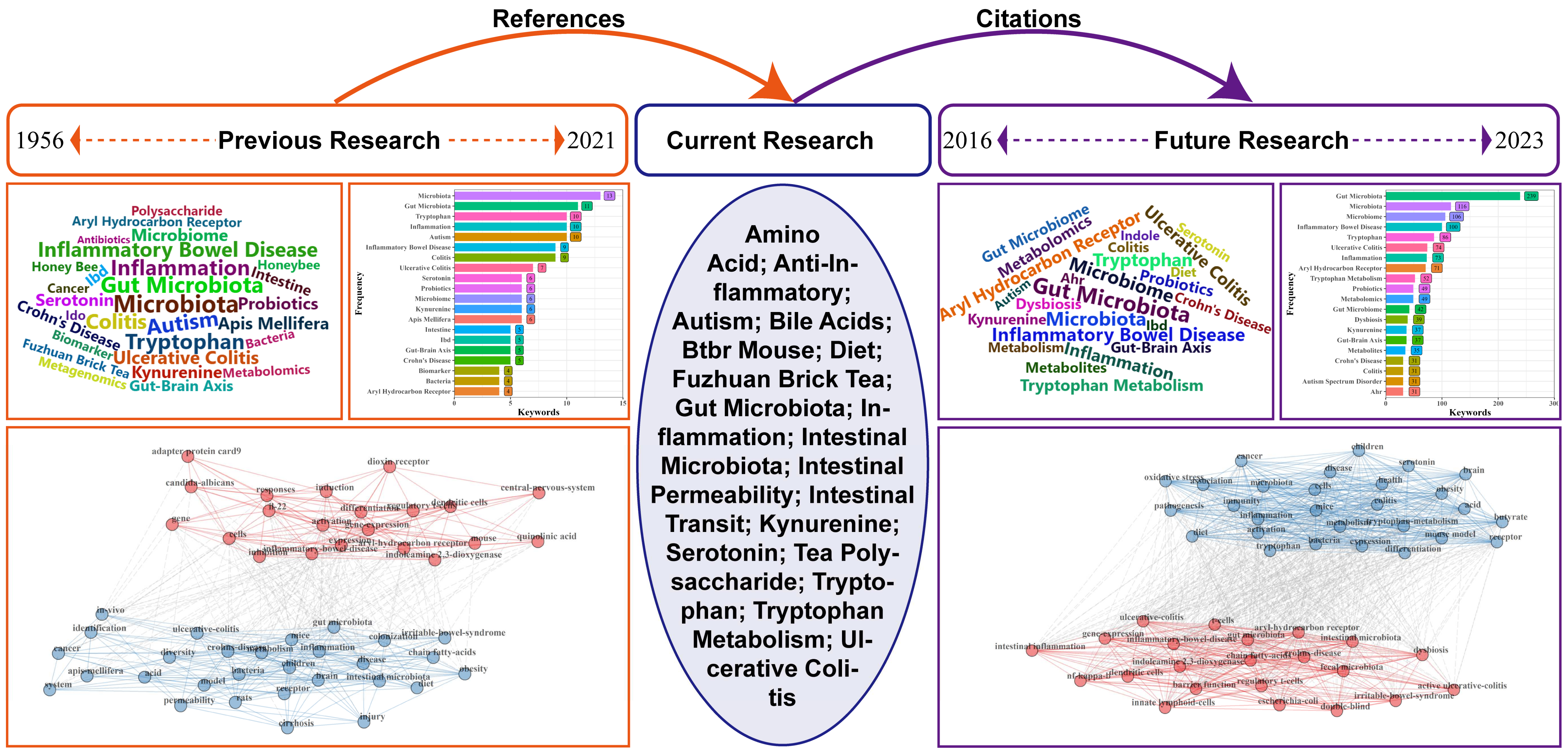
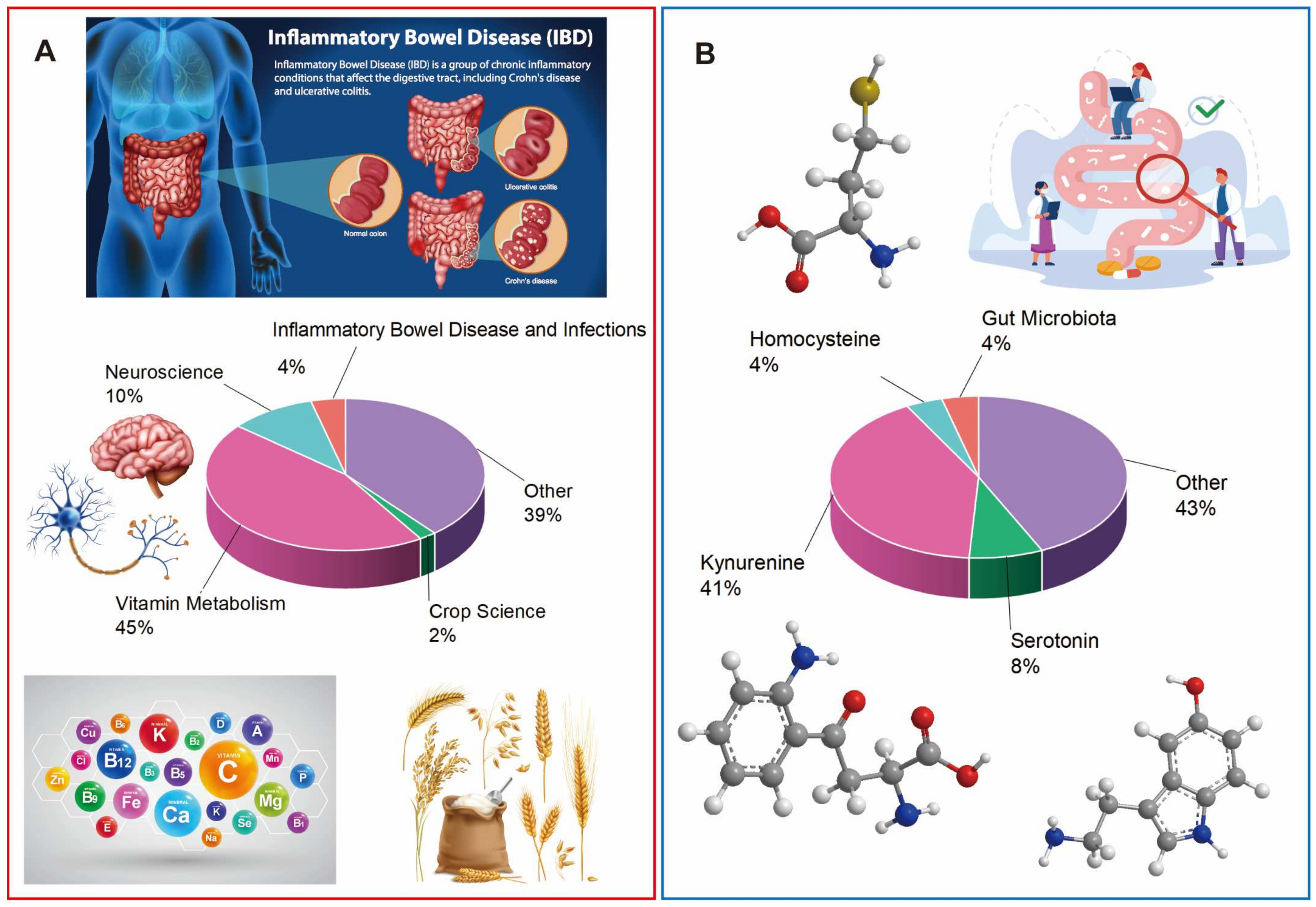
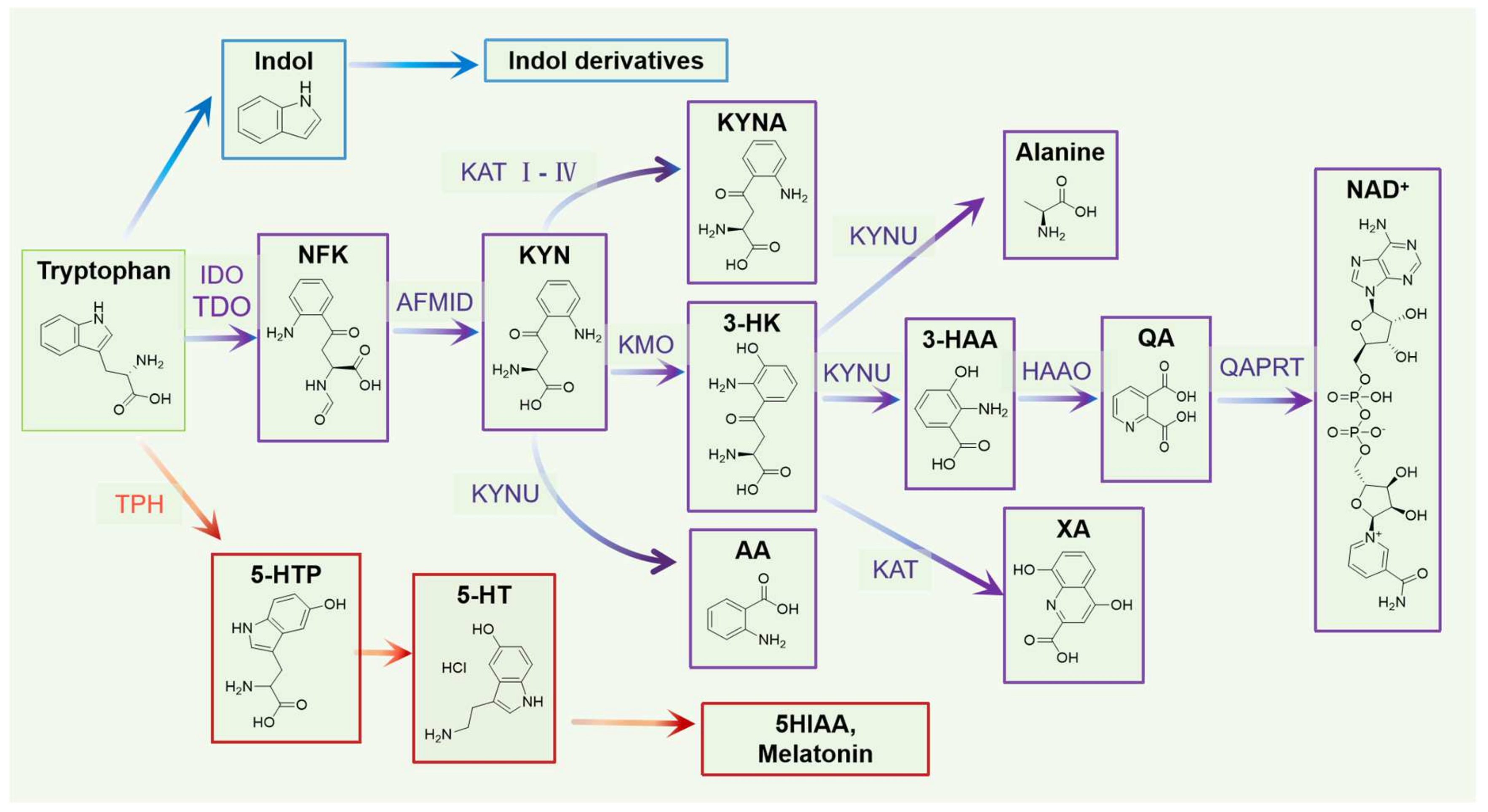
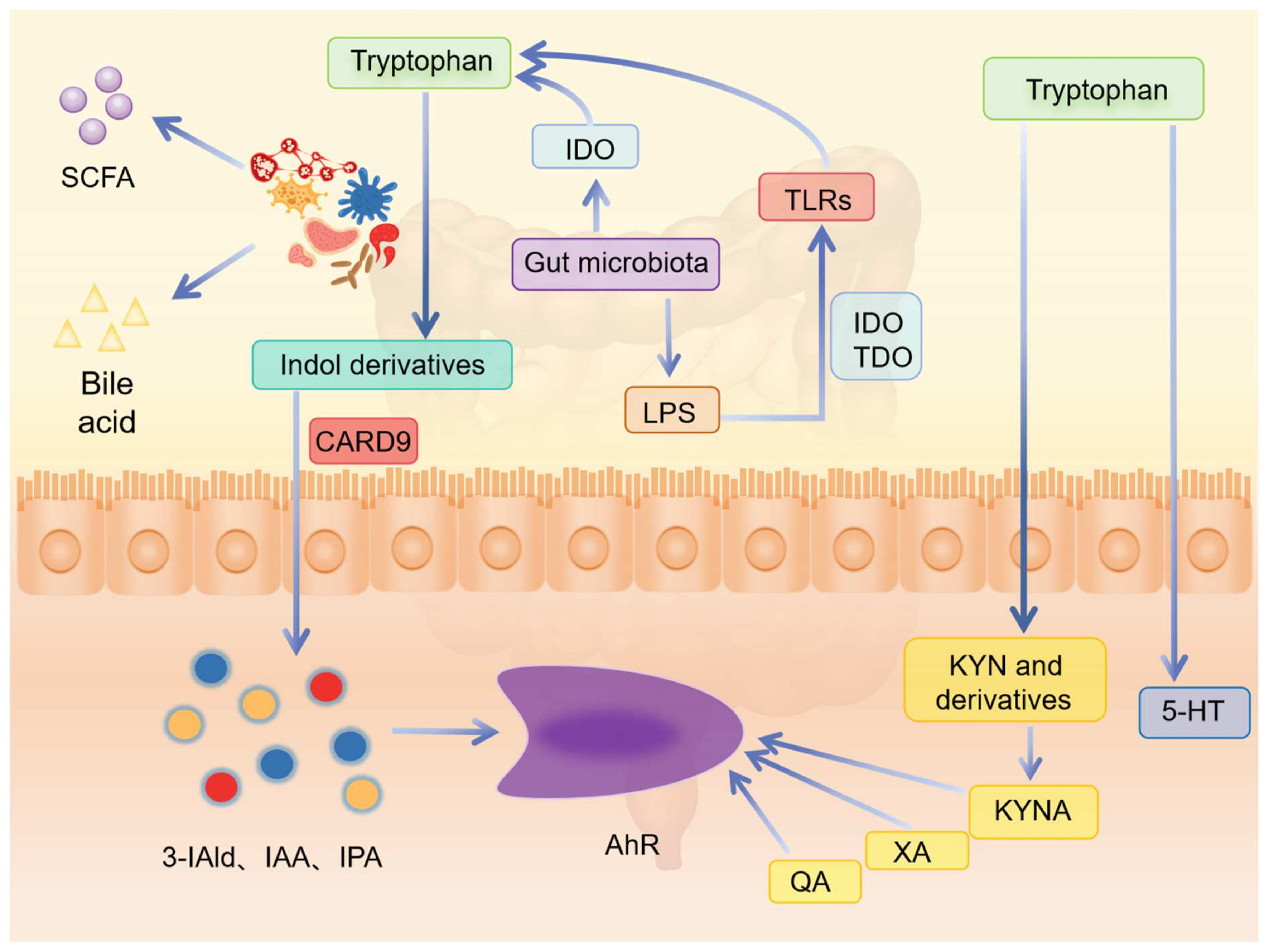
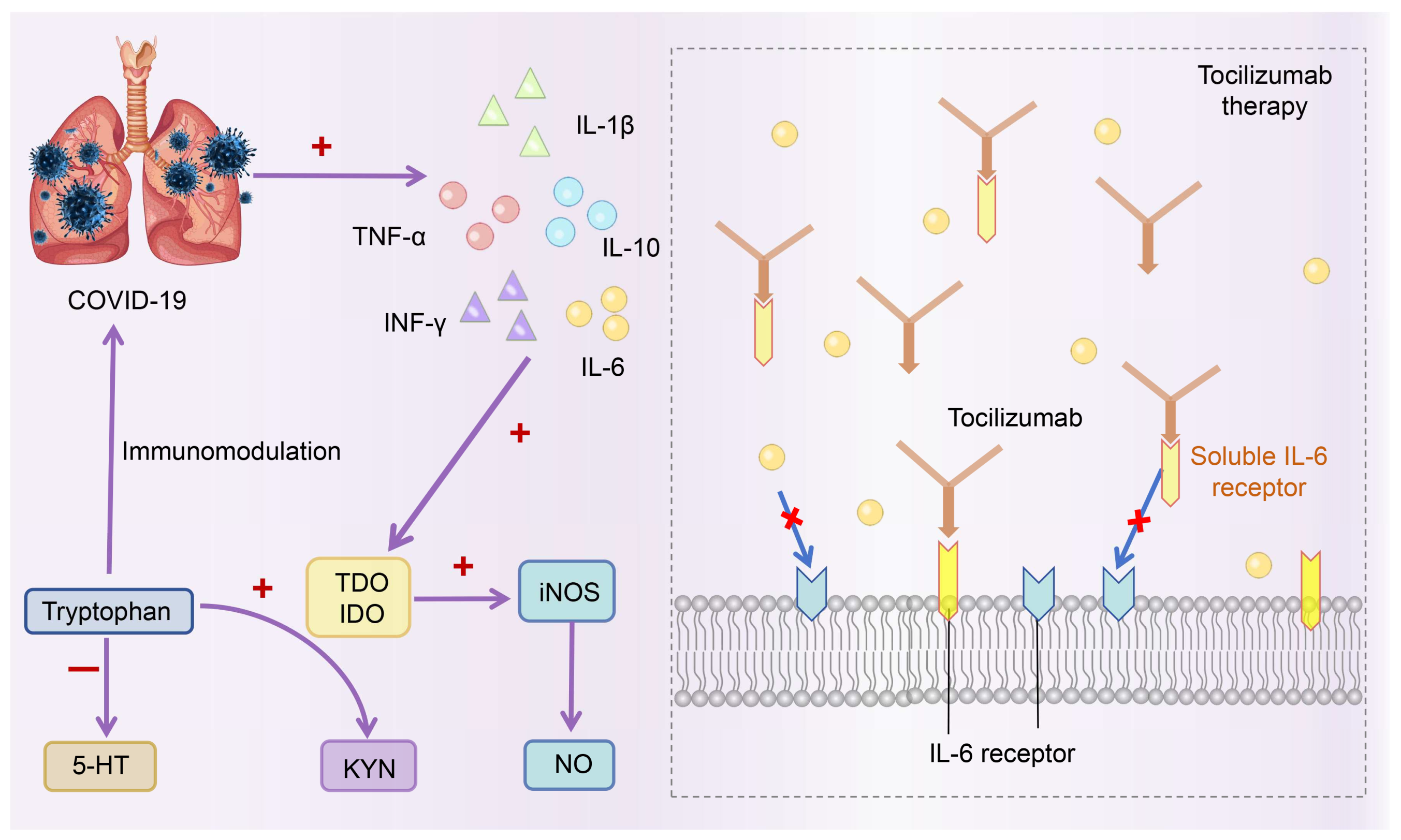
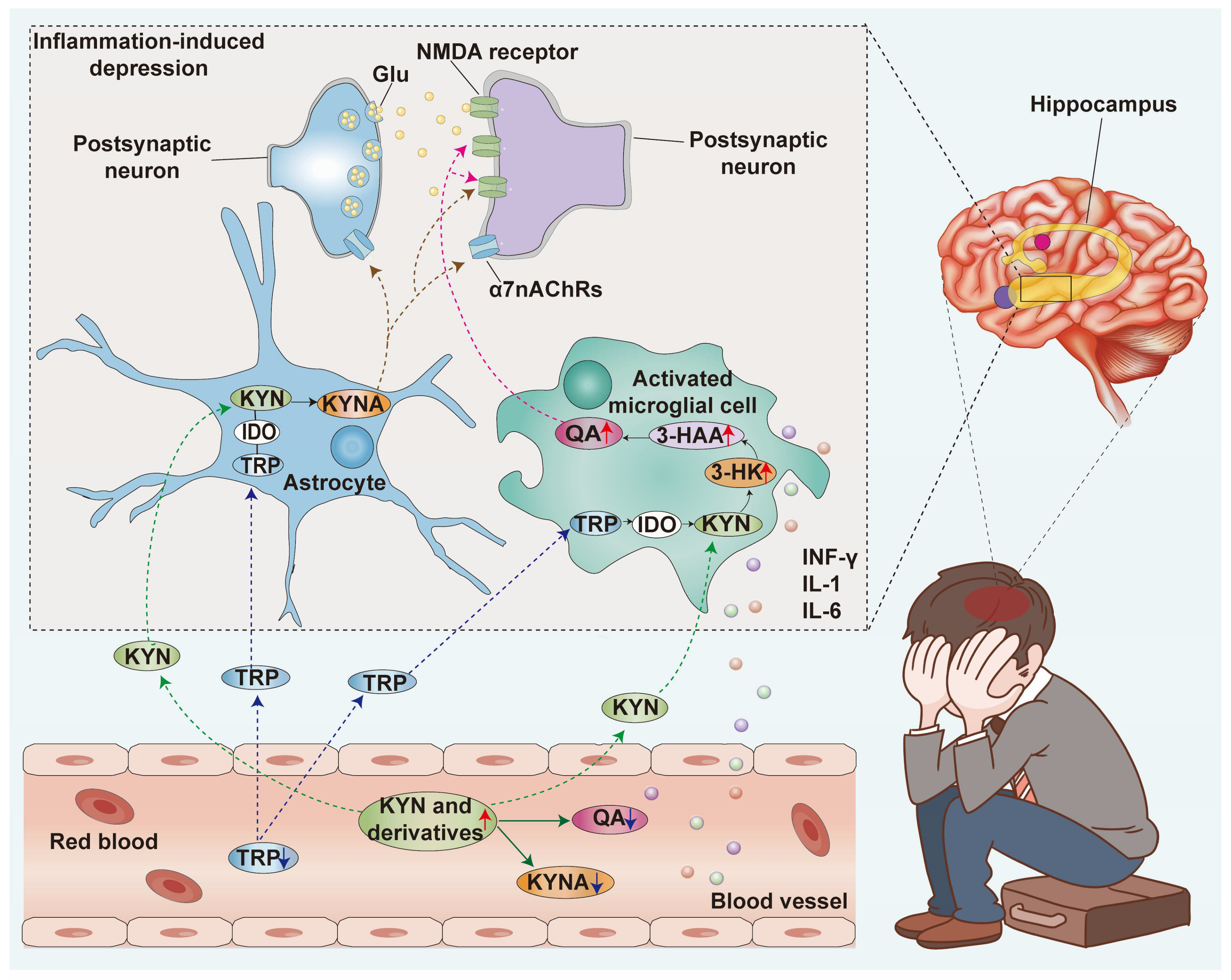
| Hotspot | Cluster | Keyword | Centrality | Frequency |
|---|---|---|---|---|
| Tryptophan metabolism pathway | 1 | tryptophan | 518.51 | 1 |
| 1 | serotonin | 84.38 | 4 | |
| 1 | quinolinic acid | 43.97 | 12 | |
| 1 | kynurenine pathway | 41.05 | 8 | |
| 1 | indoleamine 2,3-dioxygenase | 14.66 | 19 | |
| 1 | melatonin | 5.63 | 17 | |
| 1 | tryptophan 2,3-dioxygenase | 3.44 | 35 | |
| 1 | autism | 3.39 | 39 | |
| 1 | IDO1 | 0.00 | 42 | |
| 1 | kynurenines | 0.00 | 43 | |
| 1 | niacin | 0.00 | 15 | |
| 1 | nicotinamide | 0.00 | 21 | |
| 1 | rat | 0.00 | 34 | |
| 1 | NAD | 0.00 | 53 | |
| Gut microbiota | 2 | tryptophan metabolism | 342.86 | 2 |
| 2 | kynurenine | 164.30 | 3 | |
| 2 | metabolism | 26.09 | 11 | |
| 2 | gut microbiota | 20.34 | 5 | |
| 2 | metabolomics | 18.65 | 9 | |
| 2 | aging | 4.57 | 18 | |
| 2 | chronic kidney disease | 3.48 | 41 | |
| 2 | anti-inflammatory | 2.36 | 47 | |
| 2 | central nervous system | 1.20 | 48 | |
| 2 | microbiota | 0.93 | 32 | |
| 2 | ulcerative colitis | 0.72 | 23 | |
| 2 | positron emission tomography | 0.54 | 33 | |
| 2 | hippocampus | 0.18 | 29 | |
| 2 | plasma | 0.18 | 54 | |
| 2 | gut microbiome | 0.00 | 28 | |
| 2 | mass spectrometry | 0.00 | 31 | |
| COVID-19 and glioma | 3 | COVID-19 | 9.52 | 49 |
| 3 | glioma | 7.83 | 24 | |
| 3 | aryl hydrocarbon receptor | 6.97 | 16 | |
| 3 | microbiome | 4.14 | 44 | |
| 3 | colitis | 3.69 | 27 | |
| 3 | indole | 2.69 | 30 | |
| 3 | 3-dioxygenase | 2.09 | 36 | |
| 3 | indoleamine 2 | 1.41 | 25 | |
| 3 | tryptophan 2 | 0.35 | 55 | |
| Inflammation-induced depression | 4 | inflammation | 88.80 | 7 |
| 4 | depression | 29.04 | 6 | |
| 4 | kynurenic acid | 18.94 | 10 | |
| 4 | irritable bowel syndrome | 10.62 | 52 | |
| 4 | neopterin | 8.94 | 20 | |
| 4 | oxidative stress | 7.58 | 26 | |
| 4 | anxiety | 5.43 | 22 | |
| 4 | interferon-gamma | 3.06 | 51 | |
| 4 | 3-hydroxyanthranilic acid | 2.25 | 46 | |
| 4 | IDO | 1.62 | 14 | |
| 4 | L-tryptophan | 1.11 | 13 | |
| 4 | cytokine | 1.07 | 50 | |
| 4 | 3-hydroxykynurenine | 0.24 | 37 | |
| 4 | stress | 0.18 | 45 | |
| 4 | amino acids | 0.00 | 38 |
| Rank | Times Cited | The Title of Article | Year | Journal | |||
|---|---|---|---|---|---|---|---|
| Name | Country | Impact Factor (2022) | Main Conclusions | ||||
| 1 | 760 | CARD9 impacts colitis by altering gut microbiota metabolism of tryptophan into aryl hydrocarbon receptor ligands [19] | 2016 | Nature Medicine | USA | 82.9 | CARD9 alters intestinal inflammation, metabolites, and their microbial composition by affecting the binding of intestinal tryptophan metabolites to AhR [19]. |
| 2 | 243 | Increased Tryptophan Metabolism Is Associated with Activity of Inflammatory Bowel Diseases [20] | 2017 | Gastroenterology | USA | 29.4 | Tryptophan has a high degradation activity in active IBD patients, with a significant increase in metabolic product levels, such as QA. In addition, tryptophan deficiency may lead to the development of IBD [20]. |
| 3 | 186 | Microbiota-related Changes in Bile Acid & Tryptophan Metabolism are Associated with Gastrointestinal Dysfunction in a Mouse Model of Autism [21] | 2017 | EBioMedicine | Netherlands | 11.1 | Bacterial metabolism in intestinal bile metabolism is deficient in BTBR mice, and Bifidobacterium bifidum and Blautia species are reduced. Changes in gut microbiota affect gastrointestinal function and social activities in BTBR mice [21]. |
| 4 | 67 | Tryptophan metabolism drives dynamic immunosuppressive myeloid states in IDH-mutant gliomas [22] | 2021 | Nature Cancer | Germany | 22.7 | A target for immunotherapy of IDH-mutant tumors is identified: tryptophan metabolism. Evidence is provided for the existence of an intratumoral network of resident and recruited myeloid cells that are dependent on the glioma genotype [22]. |
| 5 | 66 | Microbiota tryptophan metabolism induces aryl hydrocarbon receptor activation and improves alcohol-induced liver injury [23] | 2021 | Gut | England | 24.5 | A new therapeutic target involving gut microbiota in the AhR pathway has been identified for treating alcoholic liver disease [23]. |
| 6 | 54 | Fuzhuan Brick Tea Polysaccharide Improved Ulcerative Colitis in Association with Gut Microbiota-Derived Tryptophan Metabolism [24] | 2021 | Journal of Agricultural and Food Chemistry | USA | 6.1 | FBTP may alleviate UC by regulating microbial metabolism and gut microbiota and repairing gut barrier [24]. |
| 7 | 23 | Honeybee gut Lactobacillus modulates host learning and memory behaviors via regulating tryptophan metabolism [25] | 2022 | Nature Communications | Berlin | 16.6 | Host-specific Lactobacillus strains promote memory behavior by converting tryptophan into indole derivatives that activate the AhR of the host [25]. |
Disclaimer/Publisher’s Note: The statements, opinions and data contained in all publications are solely those of the individual author(s) and contributor(s) and not of MDPI and/or the editor(s). MDPI and/or the editor(s) disclaim responsibility for any injury to people or property resulting from any ideas, methods, instructions or products referred to in the content. |
© 2024 by the authors. Licensee MDPI, Basel, Switzerland. This article is an open access article distributed under the terms and conditions of the Creative Commons Attribution (CC BY) license (https://creativecommons.org/licenses/by/4.0/).
Share and Cite
Chen, X.; Xu, D.; Yu, J.; Song, X.-J.; Li, X.; Cui, Y.-L. Tryptophan Metabolism Disorder-Triggered Diseases, Mechanisms, and Therapeutic Strategies: A Scientometric Review. Nutrients 2024, 16, 3380. https://doi.org/10.3390/nu16193380
Chen X, Xu D, Yu J, Song X-J, Li X, Cui Y-L. Tryptophan Metabolism Disorder-Triggered Diseases, Mechanisms, and Therapeutic Strategies: A Scientometric Review. Nutrients. 2024; 16(19):3380. https://doi.org/10.3390/nu16193380
Chicago/Turabian StyleChen, Xue, Dong Xu, Jie Yu, Xu-Jiao Song, Xue Li, and Yuan-Lu Cui. 2024. "Tryptophan Metabolism Disorder-Triggered Diseases, Mechanisms, and Therapeutic Strategies: A Scientometric Review" Nutrients 16, no. 19: 3380. https://doi.org/10.3390/nu16193380






